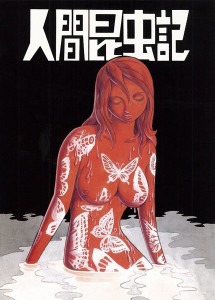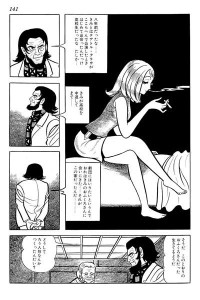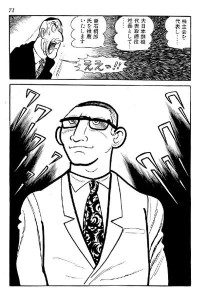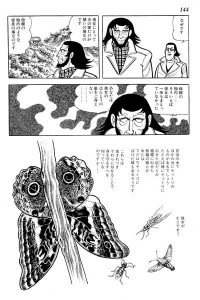Book of Human Insects, The (Manga)
Also known as 人間昆虫記 (Ningen Konchuu Ki)
| English Title: | Book of Human Insects |
| In English? | Yes |
| Japanese Title: | 人間昆虫記 Ningen Konchuu Ki |
| Type: | Ongoing Serial |
| Original run: | 1970/05/09 – 1971/02/13 |
| Published in: | Play Comic プレイコミック |
| Published by: | Akita Shoten |
| Volumes: | 2 MT-271 | MT-272 |
Another of Osamu Tezuka’s biting social satires, The Book of Human Insects (1970-71) followed his series of short stories, known collectively as Under the Air (1968-70), and was originally serialized from May 9, 1970 to February 13, 1971 in Play Comic.
What it’s about
The story opens with the beautiful and successful Toshiko Tomura, being honoured as Japan’s best new author with the prestigious Akutagawa Prize for her recent novel, The Book of Human Insects. Amazingly, this literary award is just the latest in a string of storied accomplishments for the twenty year-old wonder, having already won an award in architectural design after a stellar stint as a stage actress. A media darling, her every step is chronicled in the newspapers, on the radio and on television.
Yet, lost in the glitz and glamour is the true reason behind here success – Tomura’s greatest talent is, in fact, her ability to mimic the talents of others. It soon becomes clear that all of her great successes have come at the expense of those who’ve had the misfortune of associating closely with here. Using the beautiful good looks and playful attitude, she approaches her unwitting victim, worms her way into their confidence, and then proceeds to suck the very artistic life-force out of them. By double-crossing each of them, plagiarizing and stealing their work, and passing it off as her own, she ultimately leaves each of her victims crushed and broken – a mere husk of their former, confident selves.
Completely amoral, Tomura is totally without compassion for her former friends and lovers, and will stop at nothing, including murder, to get what she wants.
However, she meets her match in Kiriro Kamaishi, an executive with Nippon Steel. Equally as manipulative, conniving, and amoral as Tomura, the two become locked in a battle of wills – each trying to out-use the other until they eventually join forces in an uneasy alliance to scale the heights to the very top of Japan’s international business world.
What you should know
In many ways, The Book of Human Insects (1970-71) is a critical snap shot of Japanese culture in the early 1970s. It was written at the time where Japan’s headlong economic rush to rank among the top of the global GNP leaders was contrasted by the antagonism of the New Left and its anti-establishment views, the Cultural Revolution in China, the quagmire of Vietnam, and the rise indiscriminate terrorism globally. So, as Tezuka mentions in the afterword of the Osamu Tezuka Complete Manga Works edition (MT-272), “I was thinking about the yin and yang of this absurd era, and wanted to draw a single woman living a strongly Machiavellian life” (p. 186).
Also, once again inspired by Czech novelist Karel Čapek‘s work, Tezuka drew from The Life of the Insects, a satire in which insects stand in for various human characteristics, for example the flighty, vain butterfly, the obsequious, self serving dung beetle, and decided to use the world of insects as a caricature of human society – and possibly deriving the title from the essays of the famous French entomologist Jean-Henri Fabre.
As with many of the works that were produced during Tezuka’s own personal “dark period” of financial trouble and business failure, The Book of Human Insects (1970-71) offers little in the way of the hero archetypes so prevalent in Tezuka’s earlier work – something which is epitomized by the near absence of his usual Star System cast of characters. Instead, Tezuka offers up a cast of complex characters, none of which are truly innocent, that often seem to be suited for an entomologist’s specimen tray. In fact, many of the characters’ names are a parody of insects, for example, Tomura’s former lover, Hyroku Hachisuka, can be read as “butterfly” (hachi), newspaper reporter Arikawa Aokusa, as “ant” (ari), and Ryotaro Mizuno’s new love Shijimi, as “corbicula” (shijimi), a type of clam.
As such, characters often act in such a single-minded way that it suggests they are operating on a deep ingrained, almost insect-like, instinct. Of course Tomura herself is the least human of the bunch. Devoid of any real human emotion, she exists merely to grow and transform herself while “feeding” on her victims – indeed describing herself as being a larva that has not yet reached it’s final form.
While Tezuka uses this to question the true nature of human relationships, it also offers him yet another chance to explore his favourite theme of transformation. Unlike his earlier, more literal, treatments of transformation, such as the shape-shifters in Vampires (1966-69), in The Book of Human Insects (1970-71) Tezuka explores the impact of a social shape-shifter operating with an almost biological need to transform herself.
Where you can get it
Luckily, for English-speaking fans, The Book of Human Insects (1970-71) was released as a single hardcover edition, by Vertical Inc. in 2011. In 2012, Vertical Inc. republished The Book of Human Insects (1970-71) as a softcover paperback edition as well.






